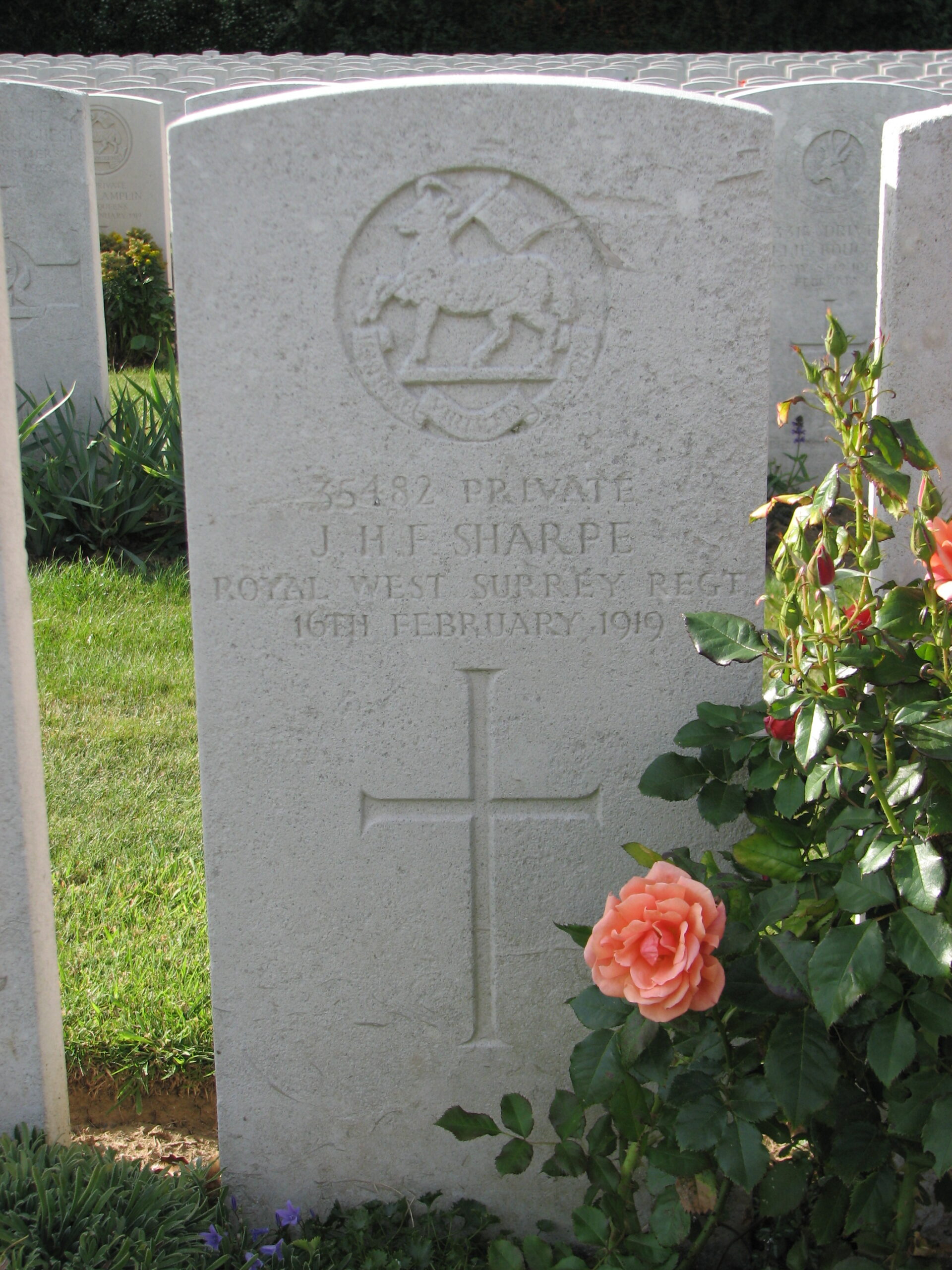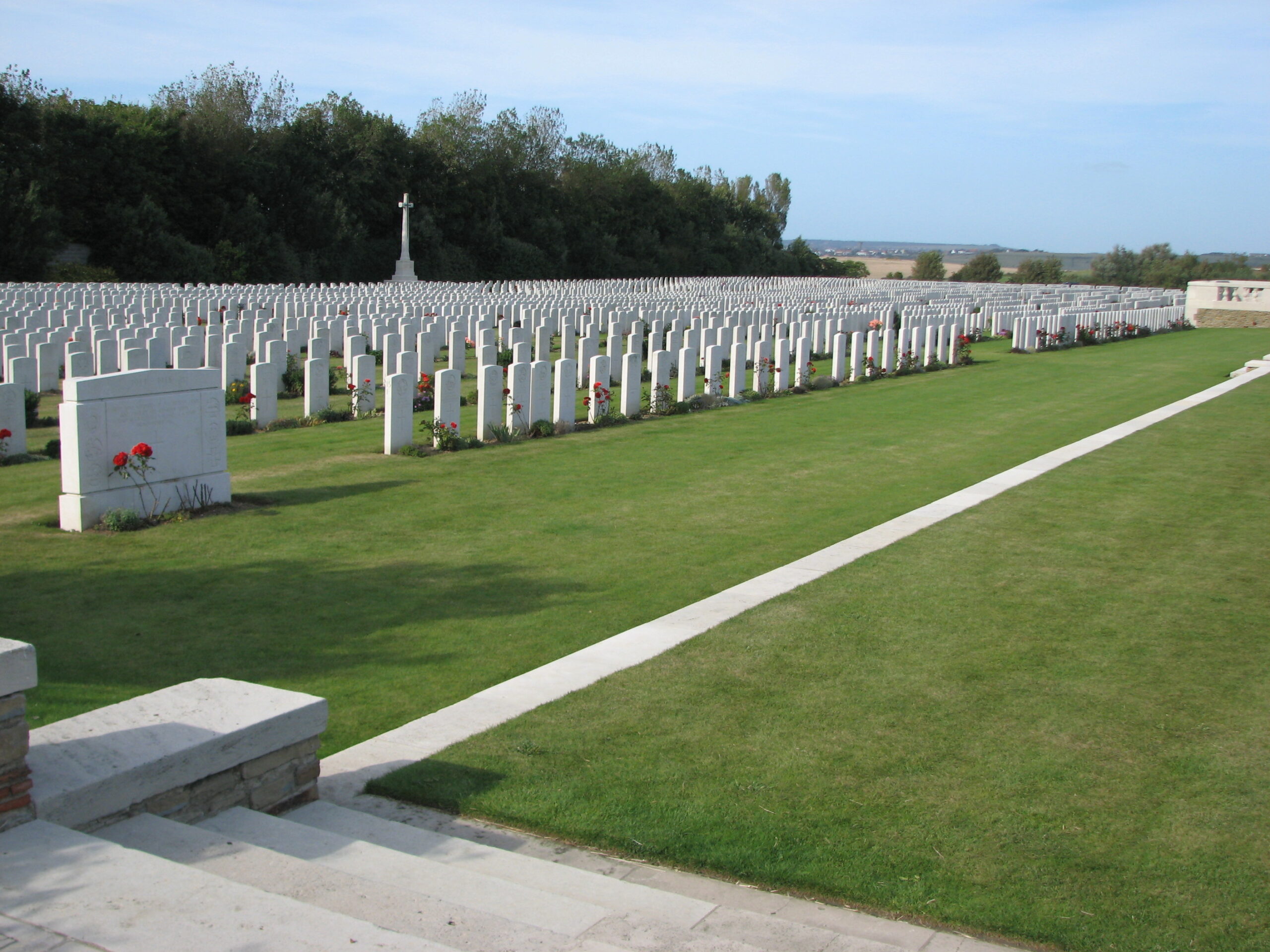Jasper Sharpe (1896 - 1919)
Jasper originally joined the Suffolk Regiment but was later transferred to The Queen’s (Royal West Surrey Regiment) and finally, to the Labour Corps. He died in a hospital on the Channel Coast, three months after the Armistice.
- 57
- Died in the Great War
- 51.972086, 1.03985
Details
| Full Name: | Jasper Henry Frederick Sharpe |
| Service: | British Army |
| Unit: | 4th Independent Labour Company, The Queen’s (Royal West Surrey Regiment); (transferred to 112th Company, The Labour Corps) |
| Regimental Number: | 35482 (Labour Corps Number 67006) |
| Rank: | Private |
| Date of Death: | 16th February 1919 |
| Age: | 22 |
| Buried: | Plot XIII, Row D, Grave 20, Terlincthun British Cemetery, Wimille, France |
Family Background and Early Life
Jasper Sharpe was born at Westley, near Bury St. Edmunds on 15th November 1896, the eldest child of George and Sarah Ann Sharpe.
George Sharpe was a Game Keeper who had been born and raised in Bury St. Edmunds. He had married Sarah Jarman from nearby Dalham, the year before Jasper was born.
The family moved around with George’s work. Jasper’s younger brother Bertram was born in February 1898 at Whaddon in Buckinghamshire. After having 2 boys, George and Sarah’s last child was a girl called Lilian, who was born in 1899 at Stutton, in Suffolk. There, the family lived at Stutton Hall Farm, close to George’s employer, Mr. Fison who owned Stutton Hall.
By April of 1911 the Sharpes had left Stutton and were living at the Keeper’s Cottage in Capel St Mary. Jasper had left school by this time, as was then the norm for a child of his age, and his occupation was described as “House Boy Domestic”.
The Sharpe family moved East Bergholt at some time between April 1911 and April 1917, where they lived at Keeper’s Cottage on Straight Road (now usually called the Mile Straight). George was employed by Mr. C.C. Eley and – as the name suggests – the cottage was tied to the job. It is not known whether Jasper actually lived with his family in East Bergholt, or whether he had joined the Army before they moved there.
Joins the Army
Unfortunately, Jasper’s Army Service Record was destroyed by German bombing during the Blitz in September 1940, so we do not know for certain some of the key dates of his military service such as when he joined up or when he was transferred between certain units.
However, we do know that initially Jasper volunteered to join the Suffolk Regiment, and there is evidence to suggest he did so in late 1914, shortly after the outbreak of war between Great Britain and Germany.
Jasper was certainly not sent overseas prior to 31 December 1915 and there is some circumstantial evidence to suggest that this may not actually have happened until late April or May 1917.
At some point after he arrived in France, Jasper was transferred from the Suffolks to the 4th Independent Labour Company of The Queen’s (Royal West Surrey Regiment). This transfer may even have occurred before Jasper had time to join a battalion of the Suffolks “in the field”, as from 1916 it became common for an infantry soldier to be posted to another regiment upon arrival in France.
The Labour Battalions, along with the Labour Companies that had been formed in some regiments, were engaged in a variety of general labouring tasks including the maintenance and also construction of large network of railways, roads, buildings, camps and also the moving of stores.
The Labour Corps
In January 1917, the Labour Corps was formed, to amalgamate all of the Army’s various labour units into one organisation. The 4th Independent Labour Company of The Queen’s (Royal West Surrey Regiment) was one of those units transferred in the spring of 1917, in the process being renamed the 112th Company of the Labour Corps. 1 At the point of transfer, any men affected would also have been given a new Regimental Number.
Almost all of the British soldiers within the Labour Corps did not meet the medical requirements required to serve in the front-line trenches, either due to age, wounds or general poor health. Despite this, being a member of the Labour Corps was certainly no soft option, many of the units were often deployed close to the front within range of the German artillery, and during the desperate days of the German offensives of 1918 were sometimes used as emergency infantry.
The Armistice was signed on 11 November 1918, but just over three months later – on 16th February 1919 – Jasper died of bronchial-pneumonia at the 32nd Stationary Hospital, situated at Wimereux, near Boulogne on the Channel Coast. This was the height of the Spanish Flu Pandemic which killed far more people than the Great War, so given Jasper’s cause of death it seems very likely that he was one of its victims.
Jasper was buried nearby in the Terlincthun British Cemetery, near Boulogne. 2 Jasper’s headstone actually shows the regimental badge of The Queen’s (Royal West Surrey Regiment), and his number relating to that Regiment. In 1919, it was decided that the headstone of a man who died whilst serving with the Labour Corps and “who had previously served in any other unit, should record his connection with his previous regiment”.
Postscript
Shortly after Jasper’s death, the Sharpe family left East Bergholt to move to Belstead, where George was employed by Major Quilter of Belstead House.
Copyright © Mark Ashmore, 2024
- 57
- Died in the Great War
- 51.972086, 1.03985




